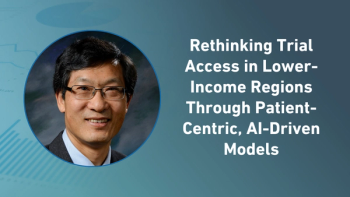
- Applied Clinical Trials-08-01-2017
- Volume 26
- Issue 8
Patient Centricity: Buzzword or Paradigm Shift in Clinical Research?
Q&A discusses how the bridging of scientific merit with the needs of patients can lead to successful clinical development.
For the pharmaceutical industry and for patients, so much hinges on the success of R&D programs. While clinical researchers have traditionally approached clinical trials from a scientific standpoint, more are beginning to approach trials with the goal of conducting scientifically rigorous evaluations with a patient-friendly approach. By engaging patients, researchers can learn more about how the disease affects the patient’s life and then design potential new treatments that not only improve patient health, but also address other “real-life” exigencies of patients. Engagement of patients can lead to greater compliance with protocol requirements, including the treatment regimen, which, in turn, can also lead to a more accurate demonstration of the efficacy of new medicinal products.
Ahead, Paulo Moreira, vice president and head of global clinical operation-external innovation at EMD Serono, discusses how successful clinical development lies in bringing together the principles of scientific merit with the needs of patients. “One cannot exist without the other.”
Q:What does true patient centricity in clinical trials mean?
Moreira: Patient centricity in clinical trials means designing clinical trials so their endpoints and objectives are in the interest of the patient community. It also carries over into implementing and executing trials in a manner that the patients and the patient community are also interested in. This means simplifying the protocol design or making it easier for patients and their caregivers to participate, like requiring doctor’s visits every six weeks instead of every two.
Q:How can the pharma industry better understand patient centricity?
Moreira: Before and during the clinical trial design process, researchers need to spend time talking to patients and relevant advocacy groups. Patients today are more educated and empowered than ever. Pharma companies must learn from them on what it means to be a patient, what they’re interested in, what they want the drug to do, what their needs are, what they are willing to do and not do as part of a clinical trial-and address these needs as part of the clinical research.
There are many means to obtain these insights: focus groups, roundtables, social media monitoring, and aggregate data, to name a few. We need to have a way to engage patients so we’re not making assumptions on what they want.
Q:How patient-centric are clinical trials today?
Moreira: In general, great progress is being made. However, efforts are inconsistent. There is not a holistic approach, but rather a patchwork of patient-centric measures that have been implemented. We recognize the need for a comprehensive approach that begins with the inclusion of patients and concludes with providing trial results to those patients-and considers them in everything that comes between.
Patient centricity must be incorporated for the entire continuum of the patients’ participation in the clinical trial.
Q:What are the benefits of adopting a patient-centric approach?
Moreira: Traditionally, pharma companies have not engaged the end consumer (a.k.a. the patient) in product design, unlike other industries. For example, the automobile industry is continually gathering feedback and incorporating it into their products. The Honda Odyssey’s built-in vacuum was the product of the insights of a 10-year-old girl who was increasingly frustrated with the accumulation of trash in the car at the end of a family road trip, and whose father was an engineer for Honda.
Employing a patient-centric strategy enables better, faster product development. We need to design trials that are relevant to the patient community, and then implement with measures that reflect the patient in the clinical research ecosystem. We’re still working on how to quantify the value of patient-centricity, but beyond the obvious benefit to patients, pharma companies can realize return on investment as well. For example, every trial has patients that drop out for various reasons-like the inability to make it to the clinic so many times per month. Usually, new patients would need to be enrolled, which calls for significant investment. However, if we’re able to decrease dropouts by designing a trial that better fits into patients’ schedules, that’s real cost savings.
With patient centricity, more patients are interested in participating during the clinical trial phase, and through their input, the final product is more attractive to the entire patient community.
The goal is to embed patient centricity throughout the entire process. Once we accomplish this, clinical trials, and the end-results of those trials, will be better for patients.
Articles in this issue
over 8 years ago
Include Pregnant Women in Trials, Urge Researchersover 8 years ago
Getting Real-World Physicians into Observational Studiesover 8 years ago
Leveraging Health IT to Improve Drug Developmentover 8 years ago
Introducing a New Era for Contract Clinical Research Servicesover 8 years ago
The Productivity Opportunity that Biopharma is Missingover 8 years ago
Considerations on Layperson Trial Summaries in the EUover 8 years ago
Increased Enrollment Efficiency With Point-of-Care Pre-Screeningover 8 years ago
The Pulse of Global TrialsNewsletter
Stay current in clinical research with Applied Clinical Trials, providing expert insights, regulatory updates, and practical strategies for successful clinical trial design and execution.






.png)



.png)



.png)
.png)
